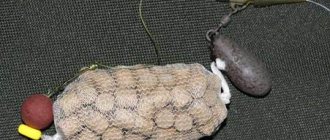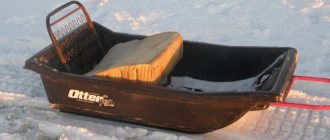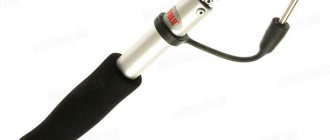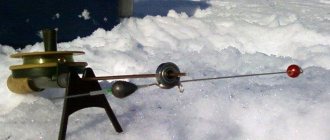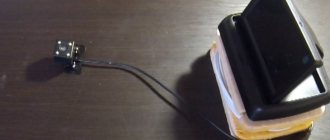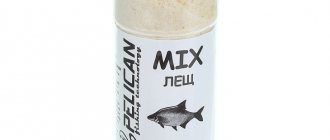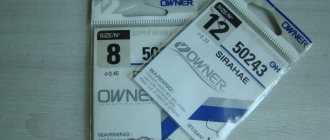If you master some of the subtleties of baiting fish using a slingshot, then under any fishing conditions and different climatic conditions you will provide yourself with not only a good catch, but also positive emotions and pleasure from a successful fishing trip!
A slingshot is a popular fishing device designed for more accurate delivery of bait mixture to the fishing spot.
They are easy to use and facilitate the process of fishing at a distance from the shore of 30–40 meters or more.
The main element of this device is rubber. It has different hardness and thickness. In fishing stores you can purchase rubber sets separately, then the casting efficiency will increase several times:
- soft should be used for throwing at short distances;
- hard - for long distances.
The casting accuracy will be excellent, up to 10 cm. Especially if you practice a little before fishing, with pebbles, for example.
Types of slingshots
Divided into two types:
- light, for crumbly bait;
- for various mixtures in lumps (balls).
The first ones are used for throwing pellets, maggots, etc. to the fishing site. You can throw a small amount of bait over short distances, up to 20 meters. They are equipped with small cups, so the mixture can only hold a little.
The second type is more common - you can throw it easily and far:
- bait mixture in large balls, for the first feeding of the place;
- accurately send smaller balls for periodic feeding to the same place.
The rubber is already harder and heavier, the cup is larger, shaped like a cone or mesh, solid:
- conical - it is more appropriate to use for a crumbly mixture that includes large granules;
- mesh - designed for small lumps of bait.
Each type of such slingshots has a different container for bait, in which you can place:
- feeding balls;
- feed bloodworm with soil;
- maggot with soil, etc.
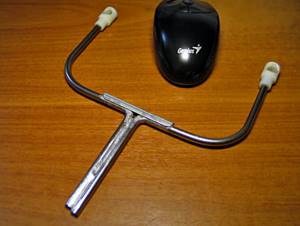
Basic elements of a slingshot
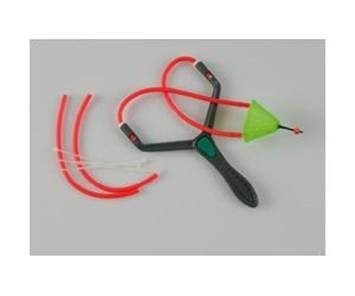
The slingshot consists of three elements: a slingshot, a tourniquet, and a cup. Depending on the bait casting distance, ropes of varying stiffness and length are used. In high-quality slingshots, the harnesses can be quickly removed and changed.
Spare harnesses can be purchased if the main ones are worn out and require replacement.
The bait is placed in a special receiver - a bowl. It is made of soft rubber or mesh. She looks different. In some models, the bowl looks like a basket, in some it looks like a hemisphere, in others it looks like a cone. The main thing is that the bait is securely held in the cup until it flies out. In some slingshots, you can change the bowls. This is convenient in cases where you need to throw balls of different sizes. In one case we attach a large bowl, and in the other - a small one.
Do it yourself
Although the modern market is overflowing with all kinds of bait slingshots for every taste, nevertheless, some more experienced fishermen prefer to make them with their own hands. Moreover, such designs are not inferior to their factory counterparts in flight range and accuracy, and even in strength. Making a slingshot is not difficult; you don’t need any special expenses or skill.
The first thing you need to do is decide on the type of slingshot.
If you decide to use a slingshot for the first time, then the ideal option is a cup-basket. It is more universal and easier to learn.
Required:
- buy a rubber Pezzer catheter at the pharmacy;
- a piece of raw thread, or waxed silk;
- a small piece of leather (a piece from the top of a chrome boot);
- find a Y-shaped fork in the forest;
- knife, scissors.
The most successful and simplest manufacturing option:
- Cut a Y-shaped fork from a living tree.
- We remove the bark and clean it.
- We dry it in a warm place for about a month (at least).
- Cut transverse circular recesses in the upper part.
- We take 2 pieces of the catheter, place them on the grooves, one at a time, and tie them tightly.
- Secure at the top with a strong thread.
- Cut out a future bowl from a piece of leather and cut holes on the sides.
- Attach the cup to the free ends using thread.

How to catch pike with a slingshot - secrets and tricks
A slingshot is a universal tool for catching pike. It can be used in the most inaccessible places where you can’t fish with a spinning rod. Pike is a cunning and treacherous fish. It most often lurks in snags, thickets of reeds and grass.
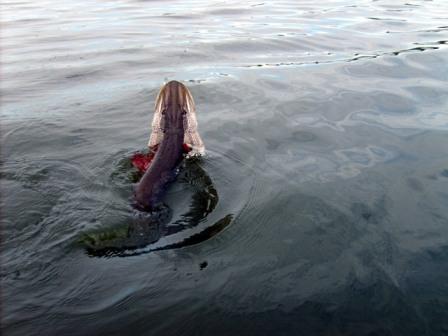
You can't do this without a slingshot.
- Having chosen a suitable place for fishing, find and cut an even whip from hazel or willow, 3-4 meters long. Tie a slingshot to the end of the whip; there is a groove on it for this. The length of the binding string is 0.5 meters.
- Freshly caught live bait is active and fast. Just what the pike needs. Therefore, do not forget to take bait fishing gear. And first catch a couple for bait.
- Almost any small fish, and even a frog, will do for live bait.
- We unwind the fishing line on the slingshot to a length sufficient for the given location, and fix the end in the crevice of the slingshot.
- We bait the bait on a hook by the upper lip or across the back and carefully lower it into the water.
- We fix the whip at an angle on the shore.
- If you slip live bait right under the nose of a predator, not even 10 minutes will pass before the prey is in your hands.
- On rivers, pike are ambushed in floodplains, in snags, on sand spits that go at an angle to depth, where fishing is most successful at night.
- Lake pike are caught in reed thickets, in shallow water, and in weed windows.
- On small bodies of water, some skilled fishermen tie the slingshot not to a whip, but to an empty plastic bottle closed with a cork. Such a device is sent for free swimming.
Using a slingshot
It is recommended to hold the slingshot not horizontally, but only vertically, so that the strands are in a vertical plane. This is the only way to achieve the greatest accuracy - shooting at an angle to the horizontal plane. Any object reaches its best flight range when its firing angle reaches 45° to the horizon.
This means that the bait ball must also be released at this angle, it will continue to fly this way. There is no need to change the angle of the shot; this can have a detrimental effect on the range and accuracy of the flight. The tourniquet must be stretched with maximum effort during the shot. It is advisable to make bait balls of the same weight and size.
Types of slingshots for fishing
Based on their functional characteristics, bait slingshots are divided into several types.
Slingshots used for fine or crumbly feed
This type of slingshot is used by fishermen to feed fish in the upper part of the water horizon. The design consists of a cup, a handle and an elastic band. It is better to make the shape of the cup cone-shaped and not made of hard material, which will protect the complementary foods from premature rash.
The thickness of the elastic band is responsible for the distance of casting: the thicker it is, the farther the bait will fly. For greater convenience, it is recommended to design several slingshots with different types of elastic bands.
The size and shape of the handle should be small and quite comfortable.
Slingshots for throwing larger bait balls
The use of slingshots of this type is more in demand and popular nowadays. The range of products is also quite extensive. They consist of a cup, an elastic band and a handle, as in the previous version.
Slingshots have two types of cups: mesh and cone-shaped. Mesh cups are considered more effective and efficient; the bait is not crushed and is securely held inside. Mesh baskets are an excellent option for throwing both small and large balls. Cone-shaped baskets will help in starting feeding using many small balls. When choosing an elastic band, you also need to base it on the thickness, which determines the throwing distance.
Blitz tips
The skill of using a slingshot will appear after several fishing trips. The eyes and hands will begin to adapt themselves and understand at what angle they need to cast to the planned distances. You will only be able to vary your efforts when stretching the elastic band to increase flight accuracy.
The wind always becomes a hindrance:
- Lateral - the casting distance will, of course, remain the same, but the bait will scatter a little along the wiring line.
- Head-on - the distance will change when throwing, especially during gusty winds. We need to wait, wait for at least a little calm.
Slingshots of a new design will soon go on sale; it was invented by the British. The handle will serve as a place for tamping the feed. There the food will turn into a dense cylinder, and from there it should fly out over long distances.
Feeding with a slingshot when fishing on a feeder
Feeding fish using a slingshot is perhaps primarily associated with match fishing in a still body of water. I had the opportunity to very effectively use this method on a small river when fishing with a feeder. I think an amateur fisherman can be forgiven for deviating from the generally accepted methods of using feeders and slingshots in fishing.
Usually I started feeder fishing on the river by measuring the depths and determining the type of soil using a heavy sinker, as well as starting feeding with a large feeder. So that all the bait spills out of the open feeder and remains at the bottom, taking out the slack in the fishing line, I make a short sharp swing with the rod. This is what I did once again, going to Zusha to catch white bream. But during the preparation process, I thought that sometimes after casting a standard feeder with a leash, the hook with bait ends up quite far from the food (since long leashes are used on the river). During repeated casts, a clipped fishing line or marking with a marker does not allow you to change the casting distance, but misses to the left and right do occur. In addition, the bait, spilling out of the feeder, is actually dispersed across the current due to the jerk of the rod. Since the fishing distance was relatively short (about 30 m), I decided to use a slingshot for massive feeding. Imagining how a ball of bait should disintegrate in the current after falling into the water, I decided to prepare food with a more viscous consistency than what was placed in the feeder. I tried to throw a small ball of bait into the shallow water. It did not crumble into dust upon impact, but only split into pieces of different sizes. Those. the larger ones were divided into small fractions only at the bottom, and a cloud of turbidity formed in the water column.

It became clear that the food had the right consistency. After some practice, I began to place tangerine-sized balls in almost the same spot with minimal spread. It must be said that with the help of a slingshot the feeding process was much faster than with a rod and feeder.
Read: Pike perch on the feeder
Probably, the feeder would object to me by saying that the same effect can be achieved with the help of a larger feeder and under-moistened bait, which spills out when it hits the water. But a too loose air mixture would be greatly washed away by water, creating an unreasonably long muddy tail that collects bleak. In addition, a large number of food bloodworms would be carried away by the current far from the fishing point. The slingshot can be loaded with small balls of bait of medium viscosity, then when it falls to the bottom it will create an appetizing trail of food particles coming off the balls. After feeding with a slingshot, a feeding spot is formed at the bottom, extended parallel to the current. Even if, when casting, the feeder falls a little away from the feeding point, the bait almost always ends up next to the food.
In addition, if during the fishing process you supplement feeding using a feeder, then it will hit the hard (in my case, rocky) bottom several times. will inevitably scare off a flock of bream for a while. Small balls of bait, softening as they fall in the water column, lie on the bottom quietly, practically without scaring the fish.
Read: Catching chub in winter with bread
The fish didn’t have to wait long and actively responded to the Sensas Feeder Gardons bait with the addition of Aromix Bremes liquid flavoring and small bloodworms with maggots. At first I was a little upset when bleak and small roach began to appear. There were concerns that the trail of bait slowly sinking to the bottom attracted only small fish and the bream simply did not have time to approach the bait. But about half an hour after the first bite of the roach, I caught a pretty good bream. Apparently, the fuss created by the small fish on the feeding spot attracted larger fish. And then every third cast brought a good dose of fishing pleasure from catching the bream.
I will describe the fishing itself and the gear that I use. On the river, I most often use a feeder. Since our rivers are small, very long casting is usually not required, and sometimes I fish from a boat. Therefore, I prefer a short 3-meter Shimano Beastmaster Sea Boat Quiver feeder and a Shimano Super 30CO S RB reel with a quick drag adjustment flag. I use monofilament fishing line Owner Broad with a diameter of 0.26 mm. It is quite soft, absorbs the jerks of the fish well, but at a short distance does not interfere with registering bites. I choose fairly thick “non-sports” leashes with a diameter of 0.14-0.18 mm. I use red-coated hooks for fishing with bloodworms or maggot sandwiches, Owner series 10255 No. 6. They are good for feeder and for line fishing on the river. I haven’t had a single slip from such hooks, and the fish takes them very confidently and hooks them well, apparently thanks to the long fore-end and narrow hook. I use a rectangular feeder, open on both sides.
Read: Working recipe for porridge for catching carp and carp
When I first tried feeding with a slingshot during feeder fishing, I discovered a shallow channel groove 30 m from the bank, further than the middle of the river in that place. I lured the steeper slope farthest from me into the ditch. It is known that bream prefers to stay in local depressions next to “tables” or in thickets of underwater vegetation. Fishing with a feeder from the shore in thick grass is almost impossible. All that remains is to either fish from a boat or choose open areas of the bottom. Naturally, the fish do not immediately gather to feed. First, the ubiquitous small fish come up, then the bites of roach and bleak become rare: this means that a bream has arrived and is feeding in a flock. To keep the fish in place, you have to feed it approximately once every 20 minutes by throwing three to five small balls. This time period is justified, since after each caught fish there is an automatic supplementary feeding with a filled feeder. When the right place is chosen, the bream never ceases to delight with bites. Moreover, even in the midst of a hot summer, it reacts better to bloodworms and maggots than to any plant baits. The bite continues until the heat of the day (until two in the afternoon). And fishing in such conditions becomes unbearable.
Fishing on a feeder
